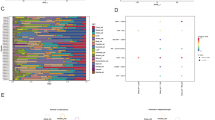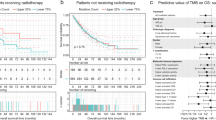Abstract
Non-small-cell lung cancer (NSCLC) demonstrates remarkable molecular diversity. With the completion of The Cancer Genome Atlas (TCGA), there is opportunity for systematic analyses of the entire TCGA NSCLC cohort, including comparisons and contrasts between different disease subsets. On the basis of multidimensional and comprehensive molecular characterization (including DNA methylation and copy, and RNA and protein expression), 1023 NSCLC cases—519 from TCGA adenocarcinoma (AD) project and 504 from TCGA squamous cell carcinoma (SQCC) project—were classified using a 'cluster-of-clusters' analytic approach. Patterns from TCGA NSCLC subsets were examined in independent external databases, including the PROSPECT (Profiling of Resistance patterns and Oncogenic Signaling Pathways in Evaluation of Cancers of the Thorax) NSCLC data set. Nine genomic subtypes of NSCLC were identified, three within SQCC and six within AD. SQCC subtypes were associated with transcriptional targets of SOX2 or p63. One predominately AD subtype (with a large proportion of SQCC) shared molecular features with neuroendocrine tumors. Two AD subtypes manifested a CpG island methylator phenotype. Three AD subtypes showed high p38 and mTOR pathway activation. AD subtypes associated with low differentiation showed relatively worse prognosis. SQCC subtypes and two of the AD subtypes expressed cancer testis antigen genes, whereas three AD subtypes expressed several immune checkpoint genes including PDL1 and PDL2, corresponding with patterns of greater immune cell infiltration. Subtype associations for several immune-related markers—including PD1, PDL1, CD3 and CD8—were confirmed in the PROSPECT cohort using immunohistochemistry. NSCLC molecular subtypes have therapeutic implications and lend support to a personalized approach to NSCLC management based on molecular characterization.
This is a preview of subscription content, access via your institution
Access options
Subscribe to this journal
Receive 50 print issues and online access
$259.00 per year
only $5.18 per issue
Buy this article
- Purchase on Springer Link
- Instant access to full article PDF
Prices may be subject to local taxes which are calculated during checkout





Similar content being viewed by others
References
Chen Z, Fillmore C, Hammerman P, Kim C, Wong K . Non-small-cell lung cancers: a heterogeneous set of diseases. Nat Rev Cancer 2014; 14: 535–546.
Thomas A, Liu S, Subramaniam D, Giaccone G . Refining the treatment of NSCLC according to histological and molecular subtypes. Nat Rev Clin Oncol 2015; 12: 511–526.
Garber M, Troyanskaya O, Schluens K, Petersen S, Thaesler Z, Pacyna-Gengelbach M et al. Diversity of gene expression in adenocarcinoma of the lung. Proc Natl Acad Sci USA 2001; 98: 13784–13789.
Beer DG, Kardia SL, Huang CC, Giordano TJ, Levin AM, Misek DE et al. Gene-expression profiles predict survival of patients with lung adenocarcinoma. Nat Med 2002; 8: 816–824.
Wilkerson M, Yin X, Hoadley K, Liu Y, Hayward M, Cabanski C et al. Lung squamous cell carcinoma mRNA expression subtypes are reproducible, clinically important, and correspond to normal cell types. Clin Cancer Res 2010; 16: 4864–4875.
Cancer Genome Atlas Research Network. Comprehensive genomic characterization of squamous cell lung cancers. Nature 2012; 489: 519–525.
Cancer Genome Atlas Research Network. Comprehensive molecular profiling of lung adenocarcinoma. Nature 2014; 511: 543–550.
Hoadley K, Yau C, Wolf D, Cherniack A, Tamborero D, Ng S et al. Multiplatform analysis of 12 cancer types reveals molecular classification within and across tissues of origin. Cell 2014; 158: 929–944.
Aran D, Sirota M, Butte A . Systematic pan-cancer analysis of tumour purity. Nat Commun 2015; 6: 8971.
Mo Q, Wang S, Seshan V, Olshen A, Schultz N, Sander C et al. Pattern discovery and cancer gene identification in integrated cancer genomic data. Proc Natl Acad Sci USA 2013; 110: 4245–4250.
Watanabe H, Ma Q, Peng S, Adelmant G, Swain D, Song W et al. SOX2 and p63 colocalize at genetic loci in squamous cell carcinomas. J Clin Invest 2014; 124: 1636–1645.
Singh A, Greninger P, Rhodes D, Koopman L, Violette S, Bardeesy N et al. A gene expression signature associated with "K-Ras addiction" reveals regulators of EMT and tumor cell survival. Cancer Cell 2009; 15: 489–500.
FANTOM Consortium and the RIKEN PMI and CLST (DGT) FANTOM Consortium and the RIKEN PMI and CLST (DGT) Forrest A FANTOM Consortium and the RIKEN PMI and CLST (DGT) Kawaji H FANTOM Consortium and the RIKEN PMI and CLST (DGT) Rehli M FANTOM Consortium and the RIKEN PMI and CLST (DGT) Baillie J FANTOM Consortium and the RIKEN PMI and CLST (DGT) de Hoon M et al. A promoter-level mammalian expression atlas. Nature 2014; 507: 462–470.
Zhang Y, Zheng X . mTOR-independent 4E-BP1 phosphorylation is associated with cancer resistance to mTOR kinase inhibitors. Cell Cycle 2012; 11: 594–603.
Bindea G, Mlecnik B, Tosolini M, Kirilovsky A, Waldner M, Obenauf A et al. Spatiotemporal dynamics of intratumoral immune cells reveal the immune landscape in human cancer. Immunity 2013; 39: 782–795.
Campbell J, Alexandrov A, Kim J, Wala J, Berger A, Pedamallu C et al. Distinct patterns of somatic genome alterations in lung adenocarcinomas and squamous cell carcinomas. Nat Genet 2016; 48: 607–616.
Sato M, Larsen J, Lee W, Sun H, Shames D, Dalvi M et al. Human lung epithelial cells progressed to malignancy through specific oncogenic manipulations. Mol Cancer Res 2013; 11: 638–650.
Creighton C, Gibbons D, Kurie J . The role of epithelial-mesenchymal transition programming in invasion and metastasis: a clinical perspective. Cancer Manag Res 2013; 5: 187–195.
Iyoda A, Makino T, Koezuka S, Otsuka H, Hata Y . Treatment options for patients with large cell neuroendocrine carcinoma of the lung. Gen Thorac Cardiovasc Surg 2014; 62: 351–356.
Lou Y, Diao L, Parra Cuentas E, Denning W, Chen L, Fan Y et al. Epithelial-mesenchymal transition is associated with a distinct tumor microenvironment including elevation of inflammatory signals and multiple immune checkpoints in lung adenocarcinoma. Clin Cancer Res 2016; 22: 3630–3642.
Garon E, Rizvi N, Hui R, Leighl N, Balmanoukian A, Eder J et al. Pembrolizumab for the treatment of non-small-cell lung cancer. N Engl J Med 2015; 372: 2018–2028.
Chae Y, Pan A, Davis A, Raparia K, Mohindra N, Matsangou M et al. Biomarkers for PD-1/PD-L1 blockade therapy in non-small-cell Lung cancer: is PD-L1 expression a good marker for patient selection? Clin Lung Cancer 2016, e-pub ahead of print 6 April 2016 doi:10.1016/j.cllc.2016.03.011.
Chiriva-Internati M, Pandey A, Saba R, Kim M, Saadeh C, Lukman T et al. Cancer testis antigens: a novel target in lung cancer. Int Rev Immunol 2012; 31: 321–343.
Ciuffreda L, Incani U, Steelman L, Abrams S, Falcone I, Curatolo A et al. Signaling intermediates (MAPK and PI3K) as therapeutic targets in NSCLC. Curr Pharm Des 2014; 20: 3944–3957.
Chen F, Zhang Y, Şenbabaoğlu Y, Ciriello G, Yang L, Reznik E et al. Multilevel genomics-based taxonomy of renal cell carcinoma. Cell Rep 2016; 14: 2476–2489.
Acknowledgements
This work was supported in part by the following grants from the National Institutes of Health (NIH) grant 2R01CA125123-09 (C. Creighton), MD Anderson’s Institutional Tissue Bank Award (2P30CA016672, I. Wistuba), and The University of Texas Lung Specialized Programs of Research Excellence grant (P50CA70907, I. Wistuba), Cancer Prevention and Research Institute of Texas (CPRIT) grant RP120713 C2 (C. Creighton) and P2 (D. Gibbons), and RP150405 (D. Gibbons) and Department of Defense PROSPECT grant (W81XWH-07-1-0306, I. Wistuba).
Author information
Authors and Affiliations
Corresponding author
Ethics declarations
Competing interests
The authors declare no conflict of interest.
Additional information
Supplementary Information accompanies this paper on the Oncogene website
Rights and permissions
About this article
Cite this article
Chen, F., Zhang, Y., Parra, E. et al. Multiplatform-based molecular subtypes of non-small-cell lung cancer. Oncogene 36, 1384–1393 (2017). https://doi.org/10.1038/onc.2016.303
Received:
Revised:
Accepted:
Published:
Issue Date:
DOI: https://doi.org/10.1038/onc.2016.303
This article is cited by
-
Global impact of somatic structural variation on the cancer proteome
Nature Communications (2023)
-
Machine learning based combination of multi-omics data for subgroup identification in non-small cell lung cancer
Scientific Reports (2023)
-
Implications of different cell death patterns for prognosis and immunity in lung adenocarcinoma
npj Precision Oncology (2023)
-
The immunopeptidome landscape associated with T cell infiltration, inflammation and immune editing in lung cancer
Nature Cancer (2023)
-
Spatial metabolomics identifies distinct tumor-specific and stroma-specific subtypes in patients with lung squamous cell carcinoma
npj Precision Oncology (2023)



